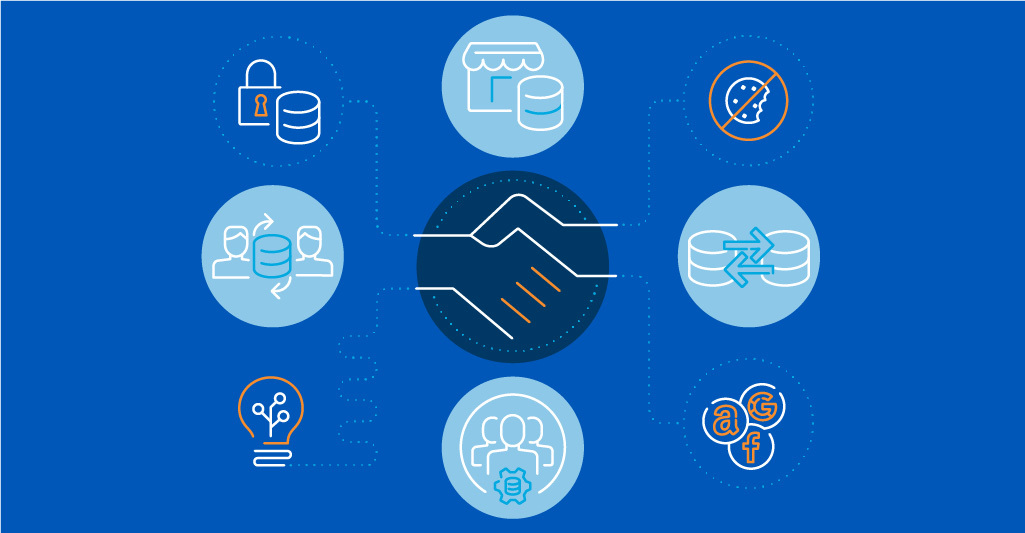If you haven’t thought about data collaboration recently, you may be missing out on a significant trend. According to a survey in the Winterberry Report, Collaborative Data Solutions: The Evolution of Identity in a Privacy-First, Post-Cookie World, 81% of brand marketers in the U.S. and 70% in the UK are currently collaborating with first-party data for insights, activation, measurement, and attribution, or are planning to.

The ability to build and act upon customer intelligence will decide the winners and losers. However, this data strategy comes with many headwinds. Cookie deprecation has played a part in this but isn’t the only factor. As the Winterberry Collaborative Data Solutions Report points out, the growing interest in data collaboration is part of a bigger picture that spans:
- New regulatory requirements
- New browser restrictions on identifiers
- Competition for revenue among media owners
- Dissatisfaction with the dominance of walled gardens and data marketplaces
- Pressures to track marketing ROI
- The drive for consistency in customer interactions
There’s much to unpack, and over the next four posts we’ll be surfacing key takeaways. First, let’s outline the four established methods of collaboration mentioned in the report: data co-ops, data marketplaces, data exchanges, and technical data environments. The report foresees a future where multiple solutions will be deployed, so it’s important to understand the building blocks of what may become the right solution for you.
The landscape of data collaboration solutions
According to the Collaborative Data Solutions report, industry experts and marketers in the UK and U.S. expect to see new forms of partnership among brands, media owners, data owners, and the technology companies that serve them.
These innovations will evolve against a backdrop of existing sharing models such as:
- Data co-ops that pool first-party data for sharing by B2B and B2C participants in a give-to-get model. For example, direct-to-consumer players use data co-ops to find new prospects, both online and offline.
- Data marketplaces that facilitate the commercial licensing of third-party data
- Data exchanges that ingest first-, second-, and third-party data assets to facilitate peer-to-peer sharing and licensing between parties on a one-to-one basis.
- Technical data environments where data is shared by multiple partners and clients in a “storage container” that facilitates the highest levels of control, privacy, and security (LiveRamp Safe Haven is an example).
These models capture the “what” of data collaboration. Here’s the how.
Solutions that fit your purpose
There are three key categories of data collaboration features shared by data co-ops, data marketplaces, data exchanges, and technical data environments:
- The kind of data collaboration they offer
- The level of risk control
- How data is accessed and the type of data used

Each of these models opened up new possibilities for collaboration and paved the way for a future built with control, privacy, and security at the forefront.
But what’s important across collaboration, risk, and data-sharing in today’s post-cookie context?
1. Data collaboration. Marketers need to be free to collaborate in any way they choose, so look for solutions that support:
- Scalability—all the way from one-to-one collaborations to the one-to-many relationships necessary for growing a partnership network.
- Engage directly with the brands most likely to help you grow and optimise your consumer intelligence, instead of relying on intermediaries.
- External and internal collaboration, so that insights and opportunities from beyond your four walls can be shared throughout the organisation.
- The right level of flexibility for your specific needs. A data exchange (Snowflake is a good example) can be very flexible in terms of the verticals it addresses—if you have the technical expertise to harness that flexibility. On the other hand, a technical data environment (such as LiveRamp Safe Haven) is specifically designed for marketers. It’s easy to use and comes with powerful tools for segmentation, activation, and reporting.
2. The ability to manage risk. With more choice of collaboration methods comes a greater need to control your data. The key here is to maximise the business value from collaboration while minimising the risk and compliance obligations associated with the ownership, processing, and storage of sensitive data.
Solutions that contain raw personal data pose risks, as do solutions that require data to be copied, which is why it’s best to look for solutions that:
- Remove PII and prevent re-identification
- Enable data analysis without needing to move or copy data
Processing data in a shared, neutral environment run by a third-party vendor means you can create valuable insights without the obligations of traditional ownership.
3. How data is accessed and the type of data used. Your data access controls should be configured in a way that serves your data strategy. One-size-fits-all approaches don’t work here—your in-house data scientist team probably needs greater access than, say, external partners.
Likewise, while record-level data is necessary for deep analytics and machine learning, it should be pseudonymised and accessed in ways that preserve privacy and prevent re-identification.
Enlarging your data sphere of influence
A broad consensus is already emerging around the need for more, and better, collaboration—and we’ll be exploring how to achieve this throughout our series of blog posts.
Winterberry’s Collaborative Data Solutions report makes it clear that the gap between the data “haves” and “have-less” will be bridged through multiparty partnering (brands, media owners, tech, and service providers) and multilevel permissioning (consumer to brand, brand to brand, and brand to media owner).
Seizing this opportunity will secure a future of compliant data collaboration on an unprecedented scale—with potentially huge and rewarding results for all.
For more on how your peers are preparing for this new age of data collaboration, download the Winterberry report, Collaborative Data Solutions: The Evolution of Identity in a Privacy-First, Post-Cookie World. It’s packed with insights from interviews with over 50 senior industry experts in the U.S. and Europe, and the results of an online survey of senior brand marketers across the U.S. and UK.
